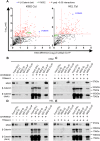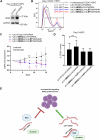β-Catenin interacts with canonical RBPs including MSI2 to associate with a Wnt signalling mRNA network in myeloid leukaemia cells
- PMID: 40301545
- PMCID: PMC12256266
- DOI: 10.1038/s41388-025-03415-y
β-Catenin interacts with canonical RBPs including MSI2 to associate with a Wnt signalling mRNA network in myeloid leukaemia cells
Abstract
Wnt/β-catenin signalling is important for normal hematopoietic stem/progenitor cell (HSPC) biology and heavily implicated in acute and chronic myeloid leukaemia (AML and CML). The central mediator β-catenin is an attractive therapeutic target in myeloid neoplasms however its targeting has been hampered by a poor characterisation of its molecular interactions in haematopoietic cells, which will differ from its network in solid tissues. Our previous β-catenin interactome study identified the significant enrichment of RNA-binding proteins (RBP) implying post-transcriptional roles for β-catenin in myeloid cells. To identify β-catenin interacting mRNAs we performed β-catenin RNA-immunoprecipitation coupled to RNA-sequencing (RIP-seq) and identified significantly enriched Wnt signalling pathway transcripts. Using β-catenin cross-linking immunoprecipitation (CLIP) we demonstrated a limited capacity for β-catenin to bind RNA directly, implying dependence on other RBPs. β-Catenin was found to interact with Musashi-2 (MSI2) in both myeloid cell lines and primary AML patient samples, where expression was significantly correlated. MSI2 knockdown reduced Wnt signalling output (TCF/LEF activity), through suppression of LEF-1 expression and nuclear localisation. Through both RIP and CLIP we demonstrate MSI2 binds LEF1 mRNA in a partly β-catenin dependent fashion, and may impact the post-transcriptional control of LEF-1 expression. Finally, we show that MSI2-mediated expansion of human HSPCs could be partly driven through LEF1 regulation. This is the first study to experimentally demonstrate functional crosstalk between MSI2 and Wnt signalling in human cells, and indicates potential novel post-transcriptional roles for β-catenin in a haematological context.
© 2025. The Author(s).
Conflict of interest statement
Competing interests: The authors declare no competing interests.
Figures








Similar articles
-
CST2 promotes cell proliferation and regulates cell cycle by activating Wnt-β-catenin signalling pathway in serous ovarian cancer.J Obstet Gynaecol. 2024 Dec;44(1):2363515. doi: 10.1080/01443615.2024.2363515. Epub 2024 Jun 12. J Obstet Gynaecol. 2024. PMID: 38864487
-
Deciphering the role of Wnt signaling in acute myeloid leukemia prognosis: how alterations in DNA methylation come into play in patients' prognosis.J Cancer Res Clin Oncol. 2020 Dec;146(12):3097-3109. doi: 10.1007/s00432-020-03407-3. Epub 2020 Sep 27. J Cancer Res Clin Oncol. 2020. PMID: 32980885 Free PMC article. Review.
-
Expression of the novel Wnt receptor ROR2 is increased in breast cancer and may regulate both β-catenin dependent and independent Wnt signalling.J Cancer Res Clin Oncol. 2015 Feb;141(2):243-54. doi: 10.1007/s00432-014-1824-y. Epub 2014 Sep 11. J Cancer Res Clin Oncol. 2015. PMID: 25209439 Free PMC article.
-
Mechanism of ABCD3 inhibiting colorectal cancer progression by regulating Wnt/β-catenin.Mol Biol Rep. 2025 Jul 16;52(1):727. doi: 10.1007/s11033-025-10825-4. Mol Biol Rep. 2025. PMID: 40668324
-
Restrictive versus liberal red blood cell transfusion strategies for people with haematological malignancies treated with intensive chemotherapy or radiotherapy, or both, with or without haematopoietic stem cell support.Cochrane Database Syst Rev. 2017 Jan 27;1(1):CD011305. doi: 10.1002/14651858.CD011305.pub2. Cochrane Database Syst Rev. 2017. Update in: Cochrane Database Syst Rev. 2024 May 23;5:CD011305. doi: 10.1002/14651858.CD011305.pub3. PMID: 28128441 Free PMC article. Updated.
Cited by
-
Post-transcriptional control of gene expression by β-catenin: expanding the non-canonical ARMoury.Oncogene. 2025 Aug;44(29):2453-2459. doi: 10.1038/s41388-025-03470-5. Epub 2025 Jun 25. Oncogene. 2025. PMID: 40562819 Free PMC article. Review.
References
-
- Nusse R, Clevers H. Wnt/beta-catenin signaling, disease, and emerging therapeutic modalities. Cell. 2017;169:985–99. 10.1016/j.cell.2017.05.016. - PubMed
-
- Reya T, Duncan AW, Ailles L, Domen J, Scherer DC, Willert K, et al. A role for Wnt signalling in self-renewal of haematopoietic stem cells. Nature. 2003;423:409–14. - PubMed
MeSH terms
Substances
Grants and funding
LinkOut - more resources
Full Text Sources
Medical
Miscellaneous

